Wu - 2013 - Key concepts and research topics in landscape ecol
Wu - 2013 - Key concepts and research topics in landscape ecol
Wu - 2013 - Key concepts and research topics in landscape ecol
You also want an ePaper? Increase the reach of your titles
YUMPU automatically turns print PDFs into web optimized ePapers that Google loves.
6 L<strong>and</strong>scape Ecol (<strong>2013</strong>) 28:1–11<br />
Fig. 3 Relative frequency<br />
of occurrencefora group of<br />
selected words <strong>and</strong> phrases<br />
that are either wellestablished<br />
terms <strong>in</strong><br />
l<strong>and</strong>scape <strong>ecol</strong>ogy or<br />
emerg<strong>in</strong>g ones <strong>in</strong>dicative of<br />
some current development<br />
fronts <strong>in</strong> the field (data<br />
derived from the titles,<br />
keywords, <strong>and</strong> abstracts of<br />
all the published papers <strong>in</strong><br />
the journal L<strong>and</strong>scape<br />
Ecology between 1987 <strong>and</strong><br />
2012). ‘‘Susta<strong>in</strong>ability<br />
related’’ refers to terms:<br />
susta<strong>in</strong>ability, susta<strong>in</strong>able<br />
development, l<strong>and</strong>scape<br />
susta<strong>in</strong>ability, susta<strong>in</strong>able<br />
l<strong>and</strong>scape, <strong>and</strong> susta<strong>in</strong>ability<br />
science<br />
seem to have passed their peaks of occurrence frequency<br />
(Fig. 4a). Is this <strong>in</strong>dicative of diversify<strong>in</strong>g <strong>research</strong><br />
<strong>topics</strong> or broaden<strong>in</strong>g scope of the field dur<strong>in</strong>g the past<br />
decade? Maybe. The substantially <strong>in</strong>creas<strong>in</strong>g number of<br />
pages published by the journal s<strong>in</strong>ce 2000 (especially<br />
after 2005) may also be partly responsible (‘‘dilution<br />
effect’’). On the other h<strong>and</strong>, though, the preselected<br />
terms represent<strong>in</strong>g new development fronts (i.e., climate<br />
change, ecosystem services, <strong>and</strong> susta<strong>in</strong>ability) show a<br />
rapidly <strong>in</strong>creas<strong>in</strong>g trend <strong>in</strong> the frequency of occurrence<br />
<strong>in</strong> the published papers <strong>in</strong> the journal (Fig. 4b).<br />
Taken together, theses results seem to confirm the<br />
essential position of the <strong>concepts</strong> of spatial heterogeneity,<br />
pattern <strong>and</strong> scale <strong>in</strong> l<strong>and</strong>scape <strong>ecol</strong>ogy, which<br />
corroborates the vision outl<strong>in</strong>ed by the Allerton Park<br />
workshop report (Risser et al. 1984). They also<br />
<strong>in</strong>dicate that many l<strong>and</strong>scape <strong>ecol</strong>ogical studies have<br />
focused on species, vegetation, habitat fragmentation<br />
(disturbances <strong>in</strong> general), conservation, <strong>and</strong> l<strong>and</strong>scape<br />
management (especially for forests). It is encourag<strong>in</strong>g<br />
to see the rapid <strong>in</strong>creases <strong>in</strong> l<strong>and</strong>scape <strong>ecol</strong>ogical<br />
studies of climate change, ecosystem services, <strong>and</strong><br />
susta<strong>in</strong>ability because the importance of these <strong>topics</strong><br />
goes far beyond basic <strong>research</strong>. Indeed, they represent<br />
the most challeng<strong>in</strong>g issues of our time; they are<br />
immediately relevant to society <strong>and</strong> policy mak<strong>in</strong>g;<br />
<strong>and</strong> l<strong>and</strong>scape <strong>ecol</strong>ogy has much to offer for advanc<strong>in</strong>g<br />
science <strong>and</strong> practice <strong>in</strong> these areas through its<br />
spatially-explicit pr<strong>in</strong>ciples <strong>and</strong> methodologies.<br />
Core questions <strong>and</strong> key <strong>topics</strong> <strong>in</strong> l<strong>and</strong>scape <strong>ecol</strong>ogy<br />
In the Allerton Park workshop report, Risser et al.<br />
(1984) stated:<br />
‘‘Because of the spatial pattern<strong>in</strong>g of l<strong>and</strong>scapes,<br />
flows <strong>and</strong> transfers between spatial components<br />
assume special importance, <strong>and</strong> the process of<br />
redistribution of organisms, materials, <strong>and</strong>/or<br />
energy among l<strong>and</strong>scape components is thus an<br />
essential feature of l<strong>and</strong>scape <strong>ecol</strong>ogy.’’<br />
Thus, different from other ‘‘<strong>ecol</strong>ogies,’’ l<strong>and</strong>scape<br />
<strong>ecol</strong>ogy focuses on the <strong>in</strong>terrelationship among<br />
sources, s<strong>in</strong>ks, flows, <strong>and</strong> redistributions <strong>in</strong> <strong>and</strong> across<br />
a l<strong>and</strong>scape mosaic that consists of multiple ecosystems<br />
(or patches). To advance such <strong>research</strong>, Risser<br />
et al. (1984) further provided four ‘‘representative<br />
questions:’’ (1) ‘‘How are fluxes of organisms <strong>and</strong> of<br />
materials <strong>and</strong> energy related to l<strong>and</strong>scape heterogeneity?’’<br />
(2) ‘‘What formative processes, both historical<br />
<strong>and</strong> present, are responsible for the exist<strong>in</strong>g pattern <strong>in</strong><br />
a l<strong>and</strong>scape?’’ (3) ‘‘How does l<strong>and</strong>scape heterogeneity<br />
affect the spread of disturbance?’’ (4) ‘‘How can<br />
conventional natural resource management be<br />
enhanced through a l<strong>and</strong>scape <strong>ecol</strong>ogy approach?’’<br />
We have come a long way <strong>in</strong> address<strong>in</strong>g these<br />
questions s<strong>in</strong>ce the Allerton Park workshop, but these<br />
questions are undoubtedly as valid today as were <strong>in</strong><br />
1984. At the turn of the new millennium, there was a<br />
123
















